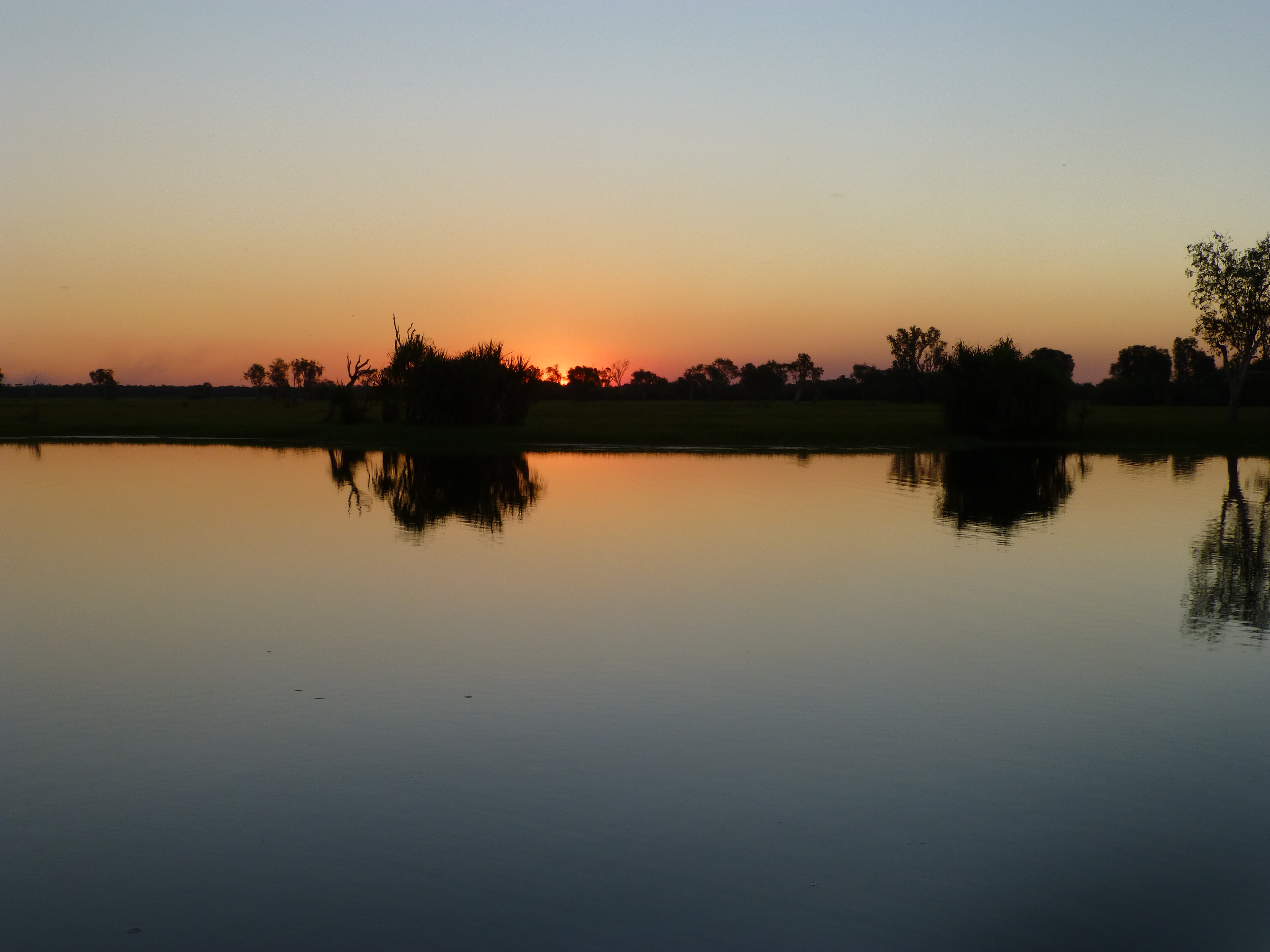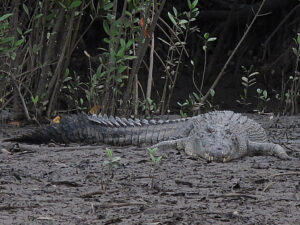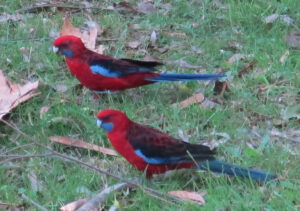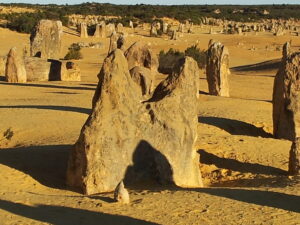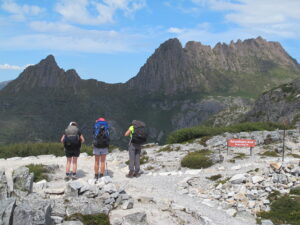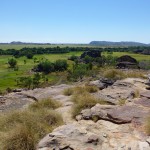
Visitors come to Kakadu mainly for the natural wonders of the area, a World Heritage designated region. Once here in the north central part of Australia at the “top end” of the Northern Territories, they discover a different, cultural reason to come as well. That’s the surprisingly well preserved and engaging art painted by aboriginal artists on rock faces here for tens of thousands of years – and well deserving of a second World Heritage recognition.
Kakadu is essentially a watershed area between Darwin and, several hundred kilometers away from Darwin, the Arnhem escarpment, a huge wall of limestone and sandstone running roughly north and south. Contiguous to the east of Kakadu is the off-limits Arnhem Land, privately owned now by local aboriginal tribes and four times its size. Together the area comprises over 100,000 square kilometres.
The area though is best understood through its seasonal variability. Though the natives know six seasons, the two main ones are the Wet and the Dry, i.e. one where lots of water flows everywhere from the bountiful rainfall and one where not much of any water is left. We were told that in the Wet, roughly from October thru April, the area rivals the Amazon in size and volume of water. In the Dry, it’s a desert except for the last vestiges of water squeezing out of the escarpment like a sponge.
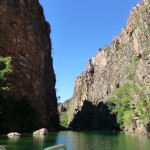
During the Wet, the temperatures are tropical, the humidity high and few tourists care to endure it, especially since you can’t reach many of the natural highlights, the highways can be impassable and it’s, well, very wet. Locals talk up the thrill of being here then, but most others aren’t buying. The hardy wait till the shoulder season around June-July, when the waters and heat start receding, you can hope to get around, but the waters are still fast running in the rivers and falls.
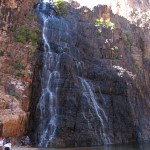
By the time of our visit in August, when temperatures are relatively cool in the low 30s Celsius (high 90s Fahrenheit) and humidity low, the principal waterfalls on the escarpment, Jim Jim and Twin, were more a trickle than a roar. Nonetheless, the latter still offered a lovely sight and the gorge access to both were still awash in color as well as lush with plant-life. We were told that in the shoulder season, their torrents can be astonishing and deafening.
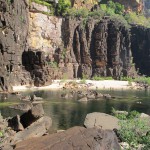
We could swim at Jim Jim, where several pools offered a refreshing dip, including one right at the dripping falls within a cylinder of steep rocky walls. There was no threat from crocodiles at this point in the season and visitors have tribal permission since those falls are known to come from woman’s dreaming in the creation dreamtime. Twin Falls, in another steep cylinder reachable only by small boat, is instead the result of male dreaming, and therefore off-limits for swimming.
The only way to see either of these is to drive deep into the outback and along the escarpment for hours over 4WD tracks, then ford a few streams, even in the Dry. We had only been touring in a hefty campervan so we reached the falls by signing on to an excellent tour.
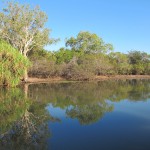
Though water levels were lowering quickly now, according to local observers, there was still enough water downstream of Jim Jim to tour the grassy and mangrove wetlands called the Yellow Water. “Not the Yellow River; that’s in China, mate,” our guide retorted after we used the wrong term.
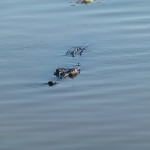
No swimming here, however, as we were introduced to a number of large resident crocodiles. Instead, we savored a dazzling landscape of rich greens and reflected blues all aglow in the evening light as we boated about the placid waters teeming with mullet and barramundi, rainbow bee-eaters, sea eagles, four types of kingfishers and myriad ducks.
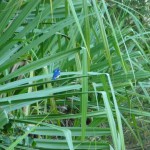 Water is inevitably the main attraction here, though we also did several dry walks, including one amid colorful sandstone formations on the edge of Arnhem Land and one to an outcropping to peer at the escarpment, the forested plains and Nourlangie Rock afire with reds and yellows in the sunset. And on foot we could circle a small lake that was still watery at this point, dotted with herons and ducks, pelicans and geese, plus a number of local wallabies hopping about in the nearby grasses.
Water is inevitably the main attraction here, though we also did several dry walks, including one amid colorful sandstone formations on the edge of Arnhem Land and one to an outcropping to peer at the escarpment, the forested plains and Nourlangie Rock afire with reds and yellows in the sunset. And on foot we could circle a small lake that was still watery at this point, dotted with herons and ducks, pelicans and geese, plus a number of local wallabies hopping about in the nearby grasses.
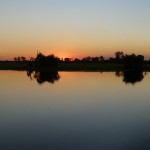
The dry season is not just the tourist season, but the burning season as well. The land management wisdom of the aboriginal tribes has become the standard up here, where around 80% of the land is set afire in chunks every three years. The tribes long recognized the value of brush clearing in this way…removing habitat for lurking snakes, fostering growth of trees and bushes that have adapted to survive natural fires, and ensuring less danger of uncontrollable fires. That’s why the landscape looked so odd as we drove along or walked the trails: scattered fire-resistant eucalypt and wattle trees, solitary boabs with their water-filled barrel-like trunks, few bushes and the everpresent dry, spiky hay-like grass less than three years old. Where a section has been newly burnt, the trunks of the trees are blackened, though the trees survive, and fertilizing ash covers the ground. You can even buy a postcard at Kakadu touting the burn-off and its effects.
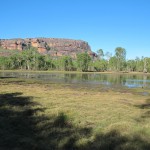
The Europeans who arrived in the last few hundred years didn’t understand the wisdom of this practice until fairly recently, and they erred in a lot of other ways too. They mistook the aboriginal name for the area, Gagudju, as Kakadu. They named several of the major rivers here for the alligator, when the large reptile was really a crododile. Even non-aboriginal guides now proudly tout the subtle insights of the tribes, as in the use of a kapok as an important chronometer. The kapok is a spindly desert tree that loses its leaves as it produces lemon yellow flowers, then produces bulbous pods that eventually disperse huge amounts of fluff to carry its seeds about. Long ago, the local tribes understood that the timing of all this was useful for connecting with a valuable food source: crocodiles are mating when the flowers appear, the females produce eggs when the pods are full, and young crocs hatch when the pods explode.
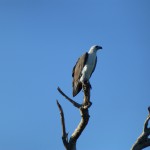
The white population and the cultural arms of the government have certainly come to appreciate the highly evolved culture of the aboriginal communities, a wisdom which is physically represented at Kakadu on the faces of rock ledges at over 5000 sites here. Certainly the artistry, now viewable by permission of the tribes, is diverse and vivid. The examples we saw at the main sites of Ubirr and Nourlangie are remarkable folk art and wholly engaging.
But the art is more than an historical relic for tribal people. Painting on rock or other materials is still often a sacramental act, more important than the result itself. That’s why the “paint” may be mixed with blood. Many examples we saw had been overpainted on prior work (at least in the past), like graffiti artists effacing another’s work on a wall, or a 20th century Italian re-doing the Last Supper fresco. A video at the fine museum in Darwin showed a contemporary painter at work as well as the subsequent celebrations of the act and the spiritual power of art-making.’
The anonymous artists painted figures, told stories, invoked spirits and showed human activities on rock faces sheltered from bleaching sun and rain by overhangs. Their “canvas” becomes a floating space for the drawings with the result a bit like a Chagall-painting.
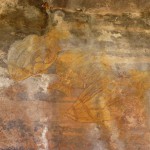
Some of the art we viewed was highly naturalistic.These pictures depict important elements of the land like the fish you can catch or the marsupials you can hunt. The remarkably detailed and lovely images of the fish in particular clearly show which are which. You can date various panels from scientific studies of when certain recognizable turtles appeared in this area. Other images include somewhat more stylized “x-ray” representations of people with skeletal features. One records the first contact with Europeans in the 17th century.
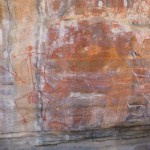
The other style is more symbolic, as well as spiritual, featuring stick figures, sometimes small and enigmatic, sometimes elongated and large scale. These are among the oldest of the paintings. They are typically the work of the Mimi, according to tribespeople, the ancestral beings from the dreamtime, the everpresent time of creation and the animating spiritual world. The Mimi passed on their craft to subsequent artists so they too could tap into the power of the dreamtime when they painted. The details of all this are a bit obscure on purpose, as the knowledge is precious and cannot be shared with those who don’t fully understand, i.e. most of us. We will likely get it wrong. (Our apologies for doing so…)
Like most folk art and stories, the resultant work offers three types of lessons on important pragmatic and spiritual learning, as if the rock faces were a teacher’s blackboard. One type of lesson usefully demonstrates how you can live off the land (what fish to eat, what trees and plants are beneficial). A second type captures how the world works. These can be creation stories as in tales of the powerful Rainbow Serpent, to whom a whole wall at Ubirr was devoted, helped by a long seam in the rock which looked like a serpent. This ancestral being shaped much of the land and continues to ensure water for the people, when not bothered in some way, as testified by rainbows reappearing in the sky. Or the figures can represent surprisingly detailed stories of weather phenomenon you need to know, involving other ancestral spirits like Namarrgon, the Lightning Man, and a grasshopper figure.
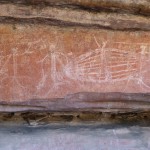
The third type of lessons deals with ethics. Several stories depicted on the rock walls used ancestral characters to explain misbehavior and its consequences. One member of a tribe steals from another and brings down catastrophe on the tribe. One violates tabus and precipitates a tribal war. Another offends the spirits by too much complaining and causes a flood harming her people.
These lessons on the value of good individual behavior struck us as particularly wise. Though individuals might be blamed for misdeeds, these pictorial stories did not seem to threaten the individual for his or her misbehavior. Unlike the individualistic western culture, the bogeyman would not get you, nor would the gods punish you alone. Instead the violations threatened the welfare of the entire community. Your misdeeds would bring harm to others you care about.
The aboriginal expression of how communal responsibility is central to life seemed, to us, not a bad lesson to learn in any season or any land.
(Also, for more pictures from Australia, CLICK HERE to view the slideshow at the end of the Australia itinerary page.)


